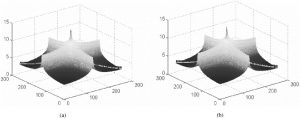Paul Gader performed his Ph.D. research in the area of Image Algebra and Mathematical Morphology and served as chair of the SPIE Image Algebra and Morphological Image Processing Conference from 1990 to 1995.
His research established a relationship between regularization theory and a class of Morphological Shared-Weight Neural Networks (MSNN) with no hidden units, calling such neural networks Morphological Regularization Neural Networks (MRNN). This relationship is established by showing that this class of MSNNs are solutions of regularization problems.
 A certain type of MSNN can be viewed as solutions to regularization problems by finding the Fourier transform of hit–miss transform and showing that erosion, dilation, and hit–miss transform can be viewed as Green’s functions. There are still many questions to be answered. This derivation relies heavily on the use of the theory of generalized functions and requires an in-depth analysis before the implications are well understood.
A certain type of MSNN can be viewed as solutions to regularization problems by finding the Fourier transform of hit–miss transform and showing that erosion, dilation, and hit–miss transform can be viewed as Green’s functions. There are still many questions to be answered. This derivation relies heavily on the use of the theory of generalized functions and requires an in-depth analysis before the implications are well understood.
Morphological Convolutional Neural Networks (MRNN) can be used in a variety of automatic detection problems. However, its effectiveness needs to be compared to that of other standard neural networks like the multi-layer perceptron and the standard/morphological shared-weight neural networks. A particular advantage to the MRNN is that no off-line training is required and additional samples can be added to the sample pool as they become available. However, this advantage can become a burden if the number of samples becomes large.
want to know more? Click on this link:
Morphological Convolutional Neural Networks
Paul Gader is an Associate Editor of the Journal of Mathematical Imaging and the Journal of Electronic Imaging. He has published over 100 technical papers, including 30 refereed journal publications.